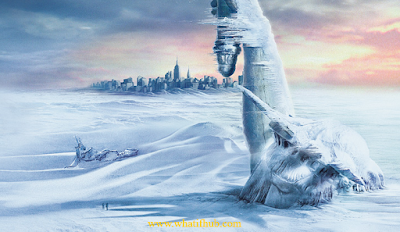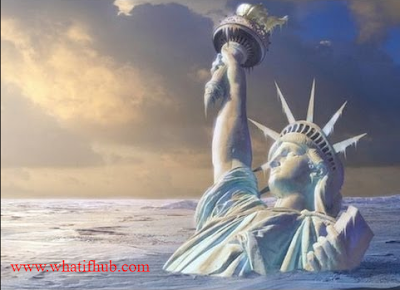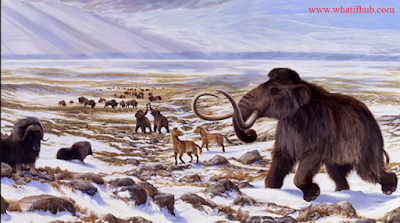An Alternate history: What if The Ice Age never ended?As winter has formally arrived, we see snow gently fall to the ground, filling us with vacation cheer before slowly crushing us in a freezing tundra.
ice ages timeline
 |
| ice ages timeline- whatifhub.com |
This extended amount of cold reminds us all, or at least me, of another time of endless cold: The ice age.
Every 100,000 years more or less, the worldwide temperature drops significantly, and ice spreads out across the northern hemisphere, covering vast areas of North America, Europe, and Siberia under glaciers.
The rest of the world experiences a significantly more relaxed and drier climate. These periods of planet-wide coldness usually are noted as ice ages.
when did the ice age end
 |
| when did the ice age end- whatifhub.com |
They last for thousands of years and then the glacier slowly recede, the planet warms back up, and also the cycle begins anew. The last ice age ended approximately 12,000 years before, so all of human history has existed in this nice...
Interglacial period, thanks to global warming! So as we enter a tiny never-ending winter of our own. Let's imagine What if in an alternate timeline? The last ice age didn't go away.
What if it never ended? The last ice age started thirty-five thousand years ago and completed 12,000 years ago.
little ice age
 |
| little ice age- whatifhub.com |
For this situation, let's say that the glaciers never really retreated once the ice age reached its max extent twenty thousand years ago.
can't survive on the ice of course, and so as the glaciers slowly went south the people migrated south too luckily for these ancient humans, there's a lot more land to colonize.
There's only enough water to go around. So the glaciers drained plenty of the ocean, lowering ocean levels almost one hundred twenty feet, dramatically altering the map and making new lands that in our timeline, have been Lost for thousands of years.
when is the next ice age
 |
when is the next ice age- whatifhub.com |
Scientists theorized that individuals settled and lived their entire lives on these currently lost regions that were once everywhere the planet for a hundred thousand years.
In this alternate timeline, had these places not been flooded by the ocean and therefore the population not dispersed, these regions are currently centers of culture, villages and hunting grounds.
Europe is divided into parts: Glacier Tundra and Plains. The Glaciers have lowered ocean levels to alter the shape of Europe.
There's no British Isles or Scandinavia. Northern Europe is one peninsula named Doggerland.
The Rhine and Tom's were attached into one super River which would drain into the Atlantic.
The sea level declined so much that the Italian and Balkan peninsula connected, generating a broad plain that resembled the fields of Russia.
Today this land is covered by the Adriatic sea. But had the ice not melted, and this region is one of the few bastions of suitable property on the frigid European continent.
Crossing the vast desert which engulfed most of Asia, we get to Present-day Southeast Asia. Today this area in Indonesia contains thousands of islands stretching down to the continent of Australia.
Twenty thousand years ago, that region was only two lands: Sunda and Sahul. Sunda's lowest point; an area now covered in ocean, was a tropical grassland comparable to India.
This grassland almost connected Going through this unified landmass until it reached the meadows of Northern Sahul, a continent which joined Papua New Guinea and Australia.
when was the last ice age
 |
when was the last ice age- https://www.whatifhub.com/ |
Before then, they had been blocked from entering the latest world by a vast wall of ice. If this enormous wall of ice doesn't melt, the native Americans don't exist.
The Americas remain the last fields on Earth without any original settlement. Without humans in the Americas, these magnificent beasts and other Megafauna would never have disappeared.
People wiped out the megafauna, not climate. While native Americans appeared to the New World 13,000 years ago, and an odd bit of irony, their hunting lifestyle with their stone tools wiped out the natural Megafauna which had survived for millions of years in the Americas.
Camels and horses, animals that ruled the Old atmosphere came from North America originally.
The only reason why the Llama was the biggest animal in the Americas at the time Columbus was because everything else died thousands of Years before.
Not just camels and horses but Mastodons, Short-faced bears, Giant sloths, Woolly Rhinos all hunted to extinction. In that alternate timeline, people never migrate into the Americas.
So today, the natural ecosystems are populated by these animals. Imagine camels on the plains of Kansas, Ground sloths in Connecticut, Elephants in California Just like this real ice wall stopped humans from growing, the ice age was a wall on the civilized advancement.
To have civilization, you need a permanent settlement. To have this you need agriculture, and it's no coincidence. Once the glaciers receded 12,000 years ago that agriculture finally began.
This was because the climate and weather were most likely so unstable that it was probably easier to hunt than to have crops that would randomly die due to the ice age.
The Ice age was the last final interception of Humanity's eventual domination over the planet. Had the ice age extended, civilization would not have.
The whole rise of a human story is in this brief moment among the glaciers. Even though winter may have started, you may have to scrape ice off your car.
It could be a whole lot different. Just because of a small difference in the Earth's circle, we have invented cars, we've developed indoor heating and the human population now numbers seven billion all over the earth. So what's the entire point of this article?
Winter, snow, and ice are terrible. They are so awful Civilization that wouldn't exist if there is more of it. We have spent 1000 of years trying to keep ourselves from experiencing winter. I am not a winter person.
* This article was originally published here






